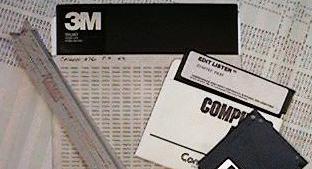|
|
|
||
|

With the advent of time code, and editors such as the CMX-600, which allowed for offline, a method for exchanging the edit list from the offline system to the online system was needed. Click here to view the original CMX edit list specification (.pdf file) Paper Tape Since the early editors generally used mini-computers, they were equipped with a Teletype Model ASR-33 printer, which could also punched and read the paper tapes. Thus the punched paper tape became the first standard for interchanging EDL's. More affluent facilities equipped their computers with "high-speed" reader/punches. While this speeded up the loading EDL's, it helped even more loading the operating program... which at times was done more often than loading edls. Click here to learn more about paper tape Floppy Disk While paper tape was economical, it had limitations. So, as floppy disk drives became available for mini-computers, they were used to store edls. The first floppy's were 8" disc's which held a whopping 250,000 bytes. Some systems adopted 5 1/2" floppy's, and eventually the widely popular 3 1/2" floppy was adopted. Punch Cards Some shows utilized punch cards to create the edl. The IBM Model 29 punch was widely available, and was used to punch the cards. Once the cards were prepared, they were read, and converted to punch tape, or floppy disc for use in the editing systems. Click here to learn more about punch cards Many of the early edit systems used the Digital Equipment PDP-11 computer. The operating system normally used with this computer was called RT-11 (Real Time for the PDP-11). The way information was stored on the floppy disc was established by this operating system. As a matter of convenience, the edit system manufactures simply adapted this format for EDL's. 409: The first edit systems had no internal list storage. As each edit was preformed, it was punched on the paper tape. At the end of the session, there would be many more edits on the tape, than were actually in the show. So Dave Bargen* developed the "409" program, which took the raw edit list and eliminated all the extra edits. Trace: The earliest offline systems were simply online edit systems equipped with less expensive helical VTR's. Since they were linear editors, any time you wanted make a change, anything after the change had to be rerecorded! So, the technique that quickly developed, was to do a first cut, then use this first cut, as a source reel, to tighten the show. This worked well, until it came time to do the auto-assembly... Unfortunately doing it this way, the time code, and reel number, for the source material was lost. To overcome this problem, Dave Bargen developed the "Trace" program. Trace takes each edit in a sub EDL, and traces it back to find the original reel number and time code.
Edit Lister: Edit Lister, written by Lon McQuillin, is an edit list management and cleaning program that debuted in 1983 on the Apple II computer. It was then ported to the IBM PC, and finally to the Macintosh in the late 1980s. Edit Lister presented a user interface that was similar to CMX-type editors, and went on to evolve into the software that ran the Edit Master editing system. Edit Lister was by far the most widely-used edit list management software, with more than 5,000 copies sold, and many more thousands "borrowed." It was originally distributed by Comprehensive Video Supply, and is now supported by McQ Software Systems. Even in today's nonlinear editing age, Edit Lister is still in use, and the DOS version is still available.
|